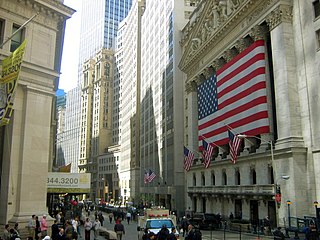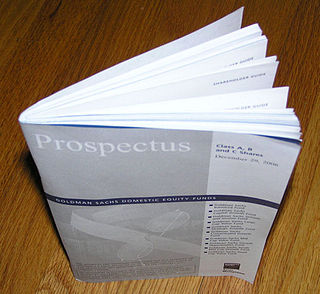Related Research Articles
In economics and finance, arbitrage is the practice of taking advantage of a difference in prices in two or more markets – striking a combination of matching deals to capitalize on the difference, the profit being the difference between the market prices at which the unit is traded. When used by academics, an arbitrage is a transaction that involves no negative cash flow at any probabilistic or temporal state and a positive cash flow in at least one state; in simple terms, it is the possibility of a risk-free profit after transaction costs. For example, an arbitrage opportunity is present when there is the possibility to instantaneously buy something for a low price and sell it for a higher price.
In finance, a high-yield bond is a bond that is rated below investment grade by credit rating agencies. These bonds have a higher risk of default or other adverse credit events but offer higher yields than investment-grade bonds in order to compensate for the increased risk. As of 2024, high-yield bonds have a higher yield than U.S. Treasury securities.

The U.S. Securities and Exchange Commission (SEC) is an independent agency of the United States federal government, created in the aftermath of the Wall Street crash of 1929. Its primary purpose is to enforce laws against market manipulation.

In finance, a bond is a type of security under which the issuer (debtor) owes the holder (creditor) a debt, and is obliged – depending on the terms – to provide cash flow to the creditor The timing and the amount of cash flow provided varies, depending on the economic value that is emphasized upon, thus giving rise to different types of bonds. The interest is usually payable at fixed intervals: semiannual, annual, and less often at other periods. Thus, a bond is a form of loan or IOU. Bonds provide the borrower with external funds to finance long-term investments or, in the case of government bonds, to finance current expenditure.
An initial public offering (IPO) or stock launch is a public offering in which shares of a company are sold to institutional investors and usually also to retail (individual) investors. An IPO is typically underwritten by one or more investment banks, who also arrange for the shares to be listed on one or more stock exchanges. Through this process, colloquially known as floating, or going public, a privately held company is transformed into a public company. Initial public offerings can be used to raise new equity capital for companies, to monetize the investments of private shareholders such as company founders or private equity investors, and to enable easy trading of existing holdings or future capital raising by becoming publicly traded.

A government bond or sovereign bond is a form of bond issued by a government to support public spending. It generally includes a commitment to pay periodic interest, called coupon payments, and to repay the face value on the maturity date.
A municipal bond, commonly known as a muni, is a bond issued by state or local governments, or entities they create such as authorities and special districts. In the United States, interest income received by holders of municipal bonds is often, but not always, exempt from federal and state income taxation. Typically, only investors in the highest tax brackets benefit from buying tax-exempt municipal bonds instead of taxable bonds. Taxable equivalent yield calculations are required to make fair comparisons between the two categories.

A credit rating agency is a company that assigns credit ratings, which rate a debtor's ability to pay back debt by making timely principal and interest payments and the likelihood of default. An agency may rate the creditworthiness of issuers of debt obligations, of debt instruments, and in some cases, of the servicers of the underlying debt, but not of individual consumers.

United States Treasury securities, also called Treasuries or Treasurys, are government debt instruments issued by the United States Department of the Treasury to finance government spending, in addition to taxation. Since 2012, the U.S. government debt has been managed by the Bureau of the Fiscal Service, succeeding the Bureau of the Public Debt.
Underwriting (UW) services are provided by some large financial institutions, such as banks, insurance companies and investment houses, whereby they guarantee payment in case of damage or financial loss and accept the financial risk for liability arising from such guarantee. An underwriting arrangement may be created in a number of situations including insurance, issues of security in a public offering, and bank lending, among others. The person or institution that agrees to sell a minimum number of securities of the company for commission is called the underwriter.
A collateralized debt obligation (CDO) is a type of structured asset-backed security (ABS). Originally developed as instruments for the corporate debt markets, after 2002 CDOs became vehicles for refinancing mortgage-backed securities (MBS). Like other private label securities backed by assets, a CDO can be thought of as a promise to pay investors in a prescribed sequence, based on the cash flow the CDO collects from the pool of bonds or other assets it owns. Distinctively, CDO credit risk is typically assessed based on a probability of default (PD) derived from ratings on those bonds or assets.
Fixed-income arbitrage is a group of market-neutral-investment strategies that are designed to take advantage of differences in interest rates between varying fixed-income securities or contracts. Arbitrage in terms of investment strategy, involves buying securities on one market for immediate resale on another market in order to profit from a price discrepancy.

Bid rigging is a fraudulent scheme in a procurement action which enables companies to submit non-competitive bids. It can be performed by corrupt officials, by firms in an orchestrated act of collusion, or by officials and firms acting together. This form of collusion is illegal in most countries. It is a form of price fixing and market allocation, often practiced where contracts are determined by a call for bids, for example in the case of government construction contracts. The typical objective of bid rigging is to enable the "winning" party to obtain contracts at uncompetitive prices. The other parties are compensated in various ways, for example, by cash payments, or by being designated to be the "winning" bidder on other contracts, or by an arrangement where some parts of the successful bidder's contract will be subcontracted to them. In this way, they "share the spoils" among themselves. Bid rigging almost always results in economic harm to the agency which is seeking the bids, and to the public, who ultimately bear the costs as taxpayers or consumers.
A guaranteed investment contract (GIC) is a contract that guarantees repayment of principal and a fixed or floating interest rate for a predetermined period of time. Guaranteed investment contracts are typically issued by life insurance companies qualified for favorable tax status under the Internal Revenue Code. A GIC is used primarily as a vehicle that yields a higher return than a savings account or United States Treasury securities and GICs are often used as investments for stable value funds. GICs are sometimes referred to as funding agreements, although this term is often reserved for contracts sold to non-qualified institutions.
The Bloomberg US Aggregate Bond Index, or the Agg, is a broad base, market capitalization-weighted bond market index representing intermediate term investment grade bonds traded in the United States. Investors frequently use the index as a stand-in for measuring the performance of the US bond market.

An auction rate security (ARS) typically refers to a debt instrument with a long-term nominal maturity for which the interest rate is regularly reset through a Dutch auction. Since February 2008, most such auctions have failed, and the auction market has been largely frozen. In late 2008, investment banks that had marketed and distributed auction rate securities agreed to repurchase most of them at par.

A prospectus, in finance, is a disclosure document that describes a financial security for potential buyers. It commonly provides investors with material information about mutual funds, stocks, bonds and other investments, such as a description of the company's business, financial statements, biographies of officers and directors, detailed information about their compensation, any litigation that is taking place, a list of material properties and any other material information. In the context of an individual securities offering, such as an initial public offering, a prospectus is distributed by underwriters or other financial firms to potential investors. Today, prospectuses are most widely distributed through websites such as EDGAR and its equivalents in other countries.
Michael Lissack is an American business executive, author, business consultant and former director of the Institute for the Study of Coherence and Emergence. In 2019 Lissack was inducted into the International Academy for Systems and Cybernetic Sciences.
The Libor scandal was a series of fraudulent actions connected to the Libor and also the resulting investigation and reaction. Libor is an average interest rate calculated through submissions of interest rates by major banks across the world. The scandal arose when it was discovered in 2012 that banks were falsely inflating or deflating their rates so as to profit from trades, or to give the impression that they were more creditworthy than they were. Libor underpins approximately $350 trillion in derivatives. It is currently administered by Intercontinental Exchange (ICE), which took over running the Libor in January 2014.
MarketAxess Holdings Inc. is an international financial technology company that operates an electronic trading platform for the institutional credit markets, and also provides market data and post-trade services. It enables institutional investors and broker-dealers to trade credit instruments, including corporate bonds, and other types of fixed income products.
References
- ↑ UPDATE/MICHAEL R. LISSACK; Wall Street Expatriate, New York Times, April 14, 2002
- ↑ "Whistleblower Says Dealers `Laundered' Bond Prices," Bloomberg News, September 2, 2008
- ↑ "Market Place;Municipal bond investors could wind up in an I.R.S. crackdown," New York Times, July 25, 1996
- 1 2 "FindLaw's United States Second Circuit case and opinions".
- ↑ "U.S. Muni probe suggests '90s market corruption redux".
- ↑ "Lissack, Sakura Battling over Yield-Burning Accusations". 28 August 2001.
- ↑ "United States ex rel. Michael Lissack v. Sakura Global Capital Markets Inc". New York Law Journal.
- ↑ "Whistleblower Lissack Takes New Shot at Muni Market: Joe Mysak - Bloomberg". Bloomberg News . 2010-10-12. Archived from the original on 2010-10-12. Retrieved 2023-05-25.
- ↑ "Bank of America to Pay $137M in Bid-Rigging Deal". 7 December 2010.
- ↑ "The Wall Street Journal - Breaking News, Business, Financial & Economic News, World News and Video".